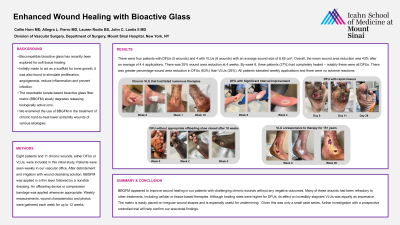Case Series/Study
(CS-072) Improved Healing of Chronic Wounds with Bioactive Glass

Methods:
Eight patients and 11 chronic wounds, either DFUs or VLUs, were included in this initial study. Patients were seen weekly in our vascular office. After debridement and irrigation with wound cleansing solution, BBGFM was applied in a thin layer followed by a nonstick dressing. An offloading device or compression bandage was applied whenever appropriate. Weekly measurements, wound characteristics and photos were gathered each week for up to 12 weeks.
Results:
There were four patients with DFUs (5 wounds) and 4 with VLUs (6 wounds) with an average wound size of 8.65 cm2. Overall, the mean wound area reduction was 43% after an average of 4.4 applications. There was 35% wound area reduction at 4 weeks. By week 8, three patients (27%) had completely healed – notably these were all DFUs. There was greater percentage wound area reduction in DFUs (63%) than VLUs (26%). All patients tolerated weekly applications and there were no adverse reactions.
Discussion: BBGFM appeared to improve wound healing in our patients with challenging chronic wounds without any negative outcomes. Many of these wounds had been refractory to other treatments, including cellular or tissue based therapies. Although healing rates were higher for DFUs, its effect on incredibly stagnant VLUs was equally as impressive. The matrix is easily placed on irregular wound shapes and is especially useful for undermining. Given this was only a small case series, further investigation with a prospective controlled trial will help confirm our anecdotal findings.
Trademarked Items: MIRRAGEN® Advanced Wound Matrix (ETS Wound Care; Rolla, Missouri)
References:

.png)